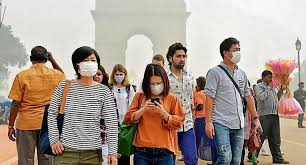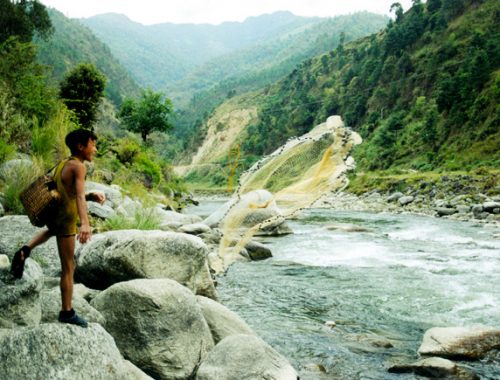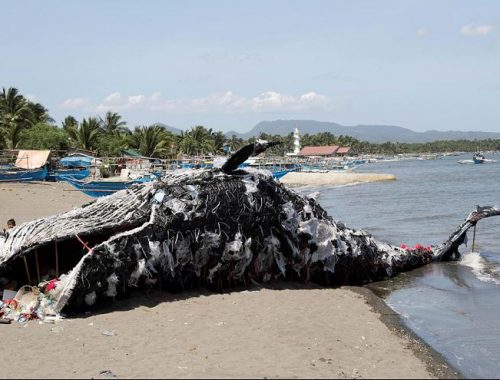The national capital was on Sunday engulfed by a dense, noxious smog that reduced visibility, brought air quality to its worst level since 2016, and made residents rue the failure of both — leaders engaged in a blame game over the causes of pollution, and experts whose best-laid plans came to naught, plunging the city into prolonged public health emergency.
In the grips of a bad air crisis since Diwali, Delhi woke up on Sunday to the stench of smoke, burning eyes, sore throats, and shortness of breath — all symptoms of a larger malaise that increases morbidity, reduces immunity, and advances mortality. According to the Central Pollution Control Board (CPCB)’s 4pm bulletin, the average air quality index (AQI) for the preceding 24 hours sharply rose from 399 to 494, the worst level recorded since November 6, 2016, when it was 497. At 11pm, the AQI dropped marginally to 480.
Air quality is considered good when the AQI is below 50 and satisfactory under 100. The concentration of PM2.5 pollutants – one of the most harmful aerosols – peaked at 992 µg/m3 in the Alipur monitoring station, over 16 times the level considered safe.
This was largely because of humidity caused by light rainfall trapping the pollutants in the air, and reacting with gases to create secondary particles that led to a sharp PM2.5 spike. Experts said pollutants such as dust and finer particles accumulated up to a height of 50 metres on Sunday, turning the city into a gas chamber. Slow wind speeds failed to flush out the pollutants.
Angered residents and pollution experts questioned the effectiveness of the Graded Response Action Plan (Grap), a set of curbs meant to be automatically implemented when pollution levels cross certain thresholds. They said it appeared to have failed, as the plan was not pre-emptive and some additional measures, such as beefing up public transport infrastructure, should have been taken to make it successful.
Mukesh Khare, professor of environmental engineering at IIT-Delhi and a member of the Supreme Court-mandated Environment Pollution (Prevention and Control) Authority (Epca), said Grap needs to be re-evaluated and reassessed to make it more efficient.
“I have already aired this many times in Epca as well as on other platforms that the Grap measures need to be revisited. Bhopal gas tragedy occurred once and it has been dealt with, but this gas tragedy is occurringevery year and is not properly dealt with. Ad hoc actions are not at all effective after the stagnation had already occurred,” he said. Pollution levels in Ghaziabad (491), Noida (495) and Greater Noida (482) remained at alarming levels. Gurugram and Faridabad were also in the “severe” category at 486 and 496 respectively, as per the four 4pm bulletin.
Twenty-one of the 37 air quality monitoring stations recorded the AQI between 490 and 500, with sensors at Aya Nagar, Ashok Vihar, Anand Vihar and Aurobindo Marg maxing out at 7pm.
The trigger of Sunday’s heavy pollution was the scanty rainfall the previous day. While the rain failed to clear the pollution, it pushed up moisture levels in the air, thus making it heavy and trapping pollutants. “Imagine yourself in a room with high levels of pollution. What would happen if you lower the height of the ceiling? The pollution would instantly increase as it would get concentrated. That’s exactly what happened in Delhi on Sunday,” said D Saha, former head of the air quality lab of CPCB.
The blanket of smog reduced the visibility to 300 metres at 8am, leading to the cancellation of 22 flights and 40 diversions throught the day at the Delhi airport. The city wore a desolated look as people stayed home amid a health advisory that asked citizens to keep doors and windows closed, and avoid morning and evening walks. The Delhi health department also urged people to avoid areas with heavy vehicular emissions and asked them to use public transport as much as possible.
Several people posted photos of alarmingly low visibility in their neighbourhoods and complained of deteriorating health conditions. An umbrella body of residents welfare associations in the Capital wrote to PM Narendra Modi to raise the issue. “Instead of fixing the problem, every single political party remains intent on fixing the blame while Indians continue to die due to the terrible air,” the letter said.
Delhi chief minister Arvind Kejriwal said: “Pollution has reached unbearable levels across north India.” He urged people to follow road rationing measures, popularly called the “odd-even scheme”, ordered by his government to run from November 4 to November 15. “I urge people to use to carpooling when they are not able to drive their car during this scheme. I will also be following the scheme strictly,” he said.
The third edition of the road rationing measures will kick in on Monday as an emergency action to control pollution. Under the scheme, private cars with odd-numbered registration plates will be allowed to run on odd dates and those with even-numbered plates will ply on even dates from 8am to 8pm, barring Sundays. The drive exempts two-wheelers and cars driven by women or carrying only women passengers, those carrying schoolchildren and electric vehicles. All private petrol, diesel and CNG in Delhi and the ones entering the city with registration numbers of different states will have to follow the rule, violating which will invite a fine of Rs 4,000.
The Union environment ministry’s System of Air Quality and Weather Forecasting And Research (Safar) warned that not much relief was expected for the next one to two days, as humidity resulting from unexpected light rains overnight had made the pollution worse.
The Aam Aadmi Party (AAP) government declared a public health emergency on Friday and closed schools and all construction activity. The Supreme Court on Monday will likely hear a petition, looking for ways to make state governments take tougher action against farmers to curb stubble-burning. Nasa satellite imagery showed vast swathes of the northern plains, covering Punjab, Haryana, Delhi, UP, Bihar, and parts of Jharkhand and West Bengal, blanketed under a smoky haze. Farm fires and emissions from firecrackers result in heavy concentrations of PM2.5 ultrafine particles in the air, which can lead to major health problems since they can enter the bloodstream after penetrating deep into the lungs.
According to Safar, satellites captured more than 3,000 incidents of farm fires last week in Punjab and Haryana, contributing to 46% of Delhi’s pollution on Friday, the season’s highest.
The period till November 15 is vulnerable to pollution spikes since this is the time when farm fires in Punjab and Haryana peak, and the resulting smoke settles over NCR and adjoining regions. Stubble left behind after the harvest is often burnt by farmers as a quick and cheap way of clearing the field for the next round of sowing.
A group of environmentalists wrote a letter to PM Modi, requesting him to save “the children, the elderly and our most-vulnerable who suffer the worst effects of pollution”.A high-level meeting chaired by PK Mishra, the principal secretary to the PM, on Sunday evening decided that cabinet secretary Rajiv Gauba will monitor the alarming pollution situation in Delhi and neighbouring states on a daily basis. Mishra reviewed the situation along with officials from Punjab, Haryana and Delhi joined the meeting through video-conferencing, according to an official statement. The chief secretaries of these states have been asked to monitor the situation in various districts of their respective states round-the-clock.
All government and private schools up to Class 12 in NCR will remain closed till Tuesday in the wake of spike in pollution levels, officials said. Gautam Buddh Nagar and Ghaziabad administrations said the decision has been taken as the levels of PM2.5 and PM 10 have been excessive in the air since Diwali.
On Diwali night, several people across the National Capital Region flouted the SC-enforced two-hour limit for bursting crackers. The apex court had also ordered that only green firecrackers, causing 30% less pollution, be sold. But a large number of illegal crackers could be heard going off across the region.
The emergency condition has sparked a blame game between state and Union ministers. Kejriwal said on Sunday the issue of pollution should not be “politicised” and called on all neighbouring states and the Centre to “sit together”, and deliberate on how to prevent stubble burning. His remarks came days after Union minister Prakash Javadekar said it was the Delhi government that sought to politicise the issue and that it failed to act in an effective manner.
The Haryana government on Sunday ordered closure of all schools in Gurugram and Faridabad on November 4 and 5 amid smog enveloping major parts of the national capital region. The order followed a similar move by the Noida administration.
(With inputs from agencies)




